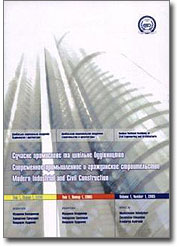The Effect of the Oxidation-Reduction Potential on the Reduction of Pathogenic Contamination of Activated Sludge During Aerobic Stabilization
Abstract: The article considers a biological method of processing excess activated sludge, based on a change in the oxidation-reduction potential of the environment, to reduce the pathogenic contamination of sludge. It is established that the conduct of the nitrification processes and the formation of oxidized nitrogen forms leads to an increase in the oxidation-reduction potential of the mixed liquor. The maximum value of the redox potential reached 500 mV on the second day of stabilization, while the concentration of nitrates was 159,00 mg/dm3. Further growth of nitrates did not affect the subsequent increase in potential. A decrease in the bacterial group of Escherichia coli in the process of aerobic stabilization of activated sludge occurred on the second day, after which the process stabilized and no further decrease in Escherichia coli occurred. Sludge treatment, that lasted for two days, allowed to reduce the pathogenic contamination in terms of the bacterial group of Escherichia coli by 75 %.
Keywords: activated sludge, aerobic stabilization, oxidation-reduction potential, nitrates, pathogenic contamination.
Pages: 167-175.
For citation:
For citation: Nezdoyminov, V. I.; Mogukalo, A. V. The Effect of the Oxidation-Reduction Potential on the Reduction of Pathogenic Contamination of Activated Sludge During Aerobic Stabilization. – Text : electronic. – In: <em>Modern Industrial and Civil Construction</em>. – 2022. – Vol. 18, N 4. – Р. 167-175. – URL: https://donnasa.ru/publish_house/journals/spgs/2022-4/st_04_nezdoyminov_mogukalo.pdf (date of access: 12.04.2025). – ISSN 1993-3495.

Vol. 18, N 4 (2022)
Journal: Modern Industrial and Civil Construction
Publish house: Donbas National Academy of Civil Engineering and Architecture
Journal: Modern Industrial and Civil Construction
Publish house: Donbas National Academy of Civil Engineering and Architecture
